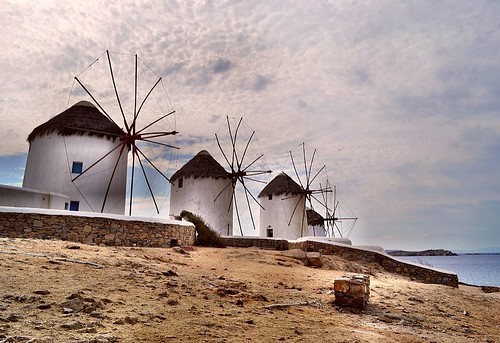Whitewashed Windmills of Mykonos
What’s the first image that pops into your mind when thinking of Mykonos? The Windmills of course! The grand Mykonian 16th century Windmills are the archetypal feature of the island’s landscape.

Wherever you gaze your eyes are bound to catch the whitewashed windmills decorating the blossoming scenery of Mykonos due to their imposing presence. The ten towering mills found dotting the shoreline of Chora are known as Kato Miloi. Their sheer grandness and snow-white splendour impress all visitors. Back in the 16th – 19th century the island was home to more than twenty windmills which were used to grind wheat that was supplied to passing ships.

Thanks to the island’s geographical position, located amongst important trade-routes which linked Venice (Europe) to Asia, Mykonos was the perfect destination for ships to stop by and load grain for their voyages. Therefore, the Mykonian Windmills were built surrounding the harbour of the island, to provide easy access to passing ships. During the 16th-19th century, the Windmills played an important role in the island’s livelihood. Due to its strong winds, as the island is also known as the Island of the Winds, the locals’ primary source of livelihood was graining wheat and supplying ships.
However, with the introduction of industrialisation, the majestic-like mills lost their financial value but have remained a popular landmark ever since. Their picture was travelled all around the world and they stand as a symbol of the island’s past.
The Windmills are now more than 100 years old. Those still standing proudly have been renovated and currently used as storage units or museums. The most famed Windmill Museum is Bonis Mill where tourists can view all the old tools and grinding machinery used back in the days.
Mykonos Windmills are a live testimony of the island’s past and must not be missed!